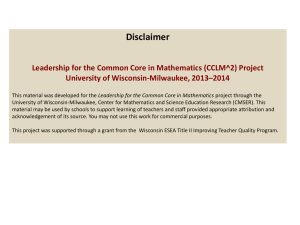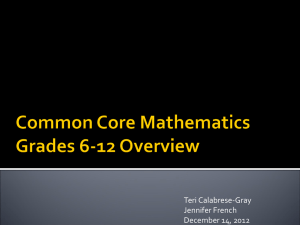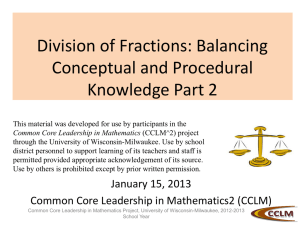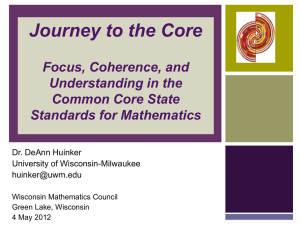ppt - University of Wisconsin–Milwaukee
advertisement
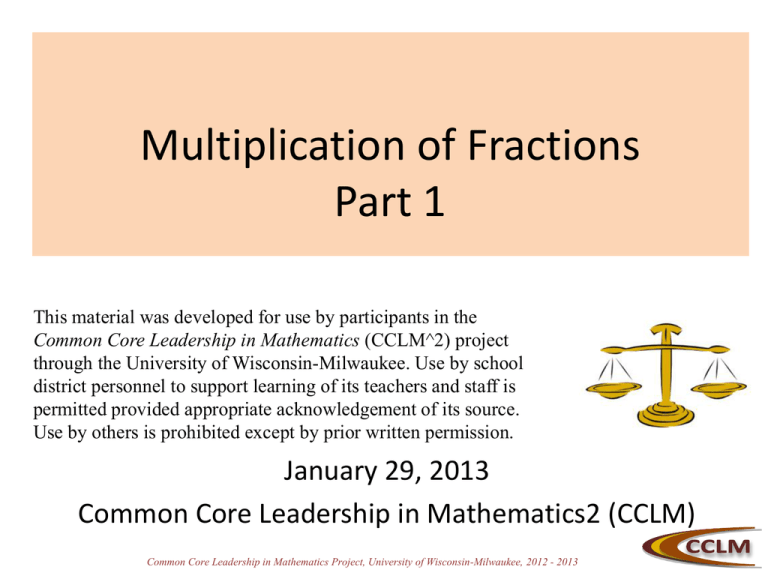
Multiplication of Fractions Part 1 This material was developed for use by participants in the Common Core Leadership in Mathematics (CCLM^2) project through the University of Wisconsin-Milwaukee. Use by school district personnel to support learning of its teachers and staff is permitted provided appropriate acknowledgement of its source. Use by others is prohibited except by prior written permission. January 29, 2013 Common Core Leadership in Mathematics2 (CCLM) Common Core Leadership in Mathematics Project, University of Wisconsin-Milwaukee, 2012 - 2013 Agenda • Project 2: Select a Common Task • Solving Multiplication Problems Using Tape Diagrams • MP 5 Common Core Leadership in Mathematics Project, University of Wisconsin-Milwaukee, 2012 - 2013 Understanding Multiplication of Fractions Using Tape Diagrams Isn’t this everything I need to know? Common Core Partnership for Mathematics Common Core Leadership in Mathematics Project, University of Wisconsin-Milwaukee, 2012 - 2013 Multiplication and Division of Fractions: Standards Progression 4.NF.4 Apply and extend previous understandings of multiplication to multiply a fraction by a whole number. c. Solve word problems involving multiplication of a fraction by a whole number, e.g., by using visual fraction models and equations to represent the problem. For example, if each person at a party will eat 3/8 of a pound of roast beef, and there will be 5 people at the party, how many pounds of roast beef will be needed? Between what two whole numbers does your answer lie? 5.NF.3 ,5.NF.4, 5.NF.5, 5.NF.6 Solve real world problems involving multiplication of fractions and mixed numbers, e.g., by using visual fraction models or equations to represent the problem. 5.NF.7, 6.NS.1 Common Core Leadership in Mathematics Project, University of Wisconsin-Milwaukee, 2012 - 2013 Standard 4.NF.4c • Read Standard 4.NF.4c • Rephrase this standard and provide an example on your slate. • Share with your partner. Common Core Leadership in Mathematics Project, University of Wisconsin-Milwaukee, 2012 - 2013 Standard 4.NF.4c 4. Apply and extend previous understandings of multiplication to multiply a fraction by a whole number. c. Solve word problems involving multiplication of a fraction by a whole number, e.g., by using visual fraction models and equations to represent the problem. For example, if each person at a party will eat 3/8 of a pound of roast beef, and there will be 5 people at the party, how many pounds of roast beef will be needed? Between what two whole numbers does your answer lie? Common Core Leadership in Mathematics Project, University of Wisconsin-Milwaukee, 2012 - 2013 Standard 5.NF.6 • Read Standard 5.NF.6 • Rephrase this standard and provide an example on your slate. • Share with your partner. Common Core Leadership in Mathematics Project, University of Wisconsin-Milwaukee, 2012 - 2013 Standard 5.NF.6 Solve real world problems involving multiplication of fractions and mixed numbers, e.g., by using visual fraction models or equations to represent the problem. Common Core Leadership in Mathematics Project, University of Wisconsin-Milwaukee, 2012 - 2013 Learning Intentions & Success Criteria • We are learning to… – Understand how to solve fraction word problems and use tape (number line) diagrams to illustrate the solutions. • We will be successful when…. – We can solve fraction word problems and use tape (number line) diagrams to illustrate the solutions. Common Core Leadership in Mathematics Project, University of Wisconsin-Milwaukee, 2012 - 2013 Money, Money, Money • David spent 2/5 of his money on a storybook. The storybook cost $20. How much money did he have at first? • On your slate, draw a model to help you solve this problem. Solve the problem. Record your thinking. Common Core Leadership in Mathematics Project, University of Wisconsin-Milwaukee, 2012 - 2013 Let’s Look at Some Sample Problems Solve the problems on pages 20 and 21(from Singapore Mathematics 4A) with your partner. Record your thinking. How did the tape diagram help you solve complicated fraction word problems? Now solve the problems on pp. 24-25 by drawing tape diagrams. Common Core Leadership in Mathematics Project, University of Wisconsin-Milwaukee, 2012 - 2013 Comparing Performance on TIMMS Items (8th grade) • Laura had $240. She spent 5/8 of it. How much money did she have left? Singapore 78%, United States 25% • Penny had a bag of marbles. She gave one-third of them to Rebecca and then one-fourth of the remaining marbles to John. Penny then had 24 marbles left in the bag. How many marbles were there to start with? Singapore 81%, United States 14% Common Core Leadership in Mathematics Project, University of Wisconsin-Milwaukee, 2012 - 2013 Sense Making…. • Share with your shoulder partner a few ideas that struck you as critical to developing a sound understanding of multiplication of fractions. Common Core Leadership in Mathematics Project, University of Wisconsin-Milwaukee, 2012 - 2013 The power of strip diagrams With the aid of simple strip diagrams, children can use straightforward reasoning to solve many challenging story problems conceptually. Beckmann 2004 Common Core Leadership in Mathematics Project, University of Wisconsin-Milwaukee, 2012 - 2013 Big Ideas A Focus on Fractions • Multiplication and division of fractions are among the most complicated fraction concepts that elementary students encounter. • Instructional opportunities that students encounter should include the meaning of multiplication and division in a range of situations and build procedural fluency with understanding. Common Core Leadership in Mathematics Project, University of Wisconsin-Milwaukee, 2012 - 2013 The School Problem • There are 3 ½ times as many fifth graders at School A as School B. There are 115 more students at School A than at School B. How many students are there at each school? • Draw a tape diagram to help you solve this problem. Common Core Leadership in Mathematics Project, University of Wisconsin-Milwaukee, 2012 - 2013 Standards for Mathematical Practice 1. Make sense of problems and persevere in solving them. 2. Reason abstractly and quantitatively. 3. Construct viable arguments & critique reasoning of others. 4. Model with mathematics. 5. Use appropriate tools strategically. 6. Attend to precision. 7. Look for and make use of structure. 8. Look for and express regularity in repeated reasoning. Common Core Leadership in Mathematics Project, University of Wisconsin-Milwaukee, 2012 - 2013 MP5 Use Appropriate Tools Strategically List 3 specific examples for: – Student Disposition: What did you do as students that illustrate this practice? – Teacher Actions: What experiences and opportunities did the teachers provide to foster the desired student dispositions? Common Core Leadership in Mathematics Project, University of Wisconsin-Milwaukee, 2012 - 2013 Learning Intentions & Success Criteria • We are learning to… – Understand how to solve fraction word problems and use tape (number line) diagrams to illustrate the solutions. • We will be successful when…. – We can solve fraction word problems and use tape (number line) diagrams to illustrate the solutions. Common Core Leadership in Mathematics Project, University of Wisconsin-Milwaukee, 2012 - 2013

